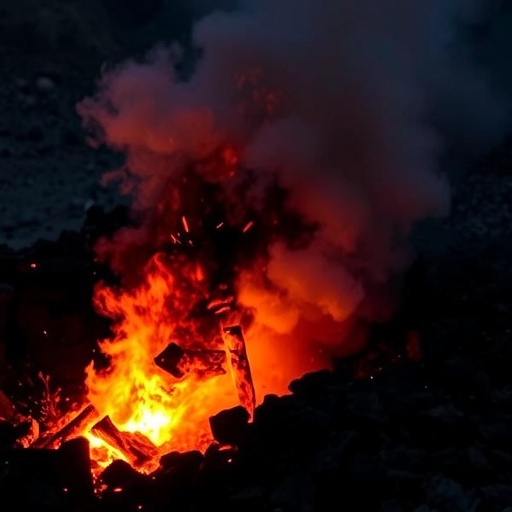In an enlightening study that investigates the intricate electrical dance between osmosis and spontaneous combustion, researchers have unveiled a ground-breaking analysis of coal’s predisposition to ignite under specific geological conditions, specifically when influenced by igneous intrusions. This topic is increasingly pertinent given the critical implications of underground coal fires on environmental and health aspects. The pivotal work by Li, Qin, and Shi et al. explores the processes of oxygen displacement and adsorption in coal—elements that significantly dictate the propensity for spontaneous combustion.
The combustion of coal, particularly in the presence of igneous rocks, presents a unique challenge due to the varying environmental pressures and thermodynamic factors involved. The researchers conducted a series of meticulously designed experiments that shed light on how intrusions impact the chemical and physical properties of coal. The key takeaway is while coal naturally contains combustible materials, interactions with magmatic rock can change its reactivity, leading to hazardous spontaneous combustion.
One of the highlights of their experimental setup was the controlled introduction of various gases, including oxygen and carbon dioxide, into coal samples subjected to thermal aging. The results indicated that as the coal aged, its capacity for oxygen retention changed remarkably, influencing the likelihood of ignition. Observations demonstrated that older coal samples exhibited a pronounced increase in reaction rates when exposed to heated conditions, further establishing a link between coal aging and spontaneous combustion dynamics.
Oxygen displacement emerged as a crucial factor in the combustion process. The study detailed how the presence of igneous intrusions alters the gas exchange dynamics within coal seams. This shift not only reduces the availability of oxygen but also changes the level of combustion efficiency. A fundamental question posed in the study was the degree to which intrusions can catalyze or hinder these reactions, ultimately shaping the fire risk associated with certain coal deposits.
To assess these interactions, the research team employed a combination of experimental methods, including high-temperature thermogravimetric analysis and gas chromatography. These methods provided insights into how the chemical composition of coal evolves when subjected to external pressures. Ultimately, they found that igneous intrusions significantly enhance the adsorption capacity of coal, making it much more reactive under specific thermal conditions.
Through sophisticated modeling, the researchers also hinted at the broader implications of their findings for fire management strategies in coal mining areas. The intricate balance of oxygen displacement and adsorption in coal requires vigilant monitoring, especially in regions where geological activity is prevalent. Ignoring these factors can result in catastrophic events that ravage ecosystems and result in significant economic losses.
The implications of this research extend well beyond the scientific community. As wildfires become more rampant due to climate change, understanding spontaneous combustion’s mechanisms can help vector management strategies. Industries relying on coal extraction can significantly benefit from predictive models based on these findings, allowing them to better anticipate and mitigate fire risks associated with coal seams.
Moreover, the results could fuel further advancements in sustainable mining practices, highlighting the need for ongoing research into the geochemical environments surrounding coal deposits. The intersection of geology, chemistry, and environmental science offers a rich tapestry for future investigations, given that the interactions between coal, surrounding soil, and intrusions can vary considerably from one locale to another.
Given the findings of this study, immediate avenues for additional research can be identified. Investigating the long-term ecological impacts of spontaneous combustion is one essential thread that researchers should pursue. As coal fires change the landscape, it is critical to understand their effects on flora and fauna in affected regions. This knowledge could prove invaluable for future conservation efforts.
Additionally, urban planning and disaster preparedness in areas near coal deposits must evolve alongside this new knowledge. By incorporating these findings into infrastructure development, towns and cities can gear their disaster response plans to be more proactive, potentially saving lives and resources in the process.
This research lays the groundwork for a deeper understanding of underground phenomena that have long been overlooked. The findings signal an urgent call to both the mining sector and environmental policymakers that coal’s unique interactions with geological factors merit detailed scrutiny. Routine assessments that incorporate these variables will be vital in ensuring that communities remain safe and economically resilient.
Owing to its complex nature, spontaneous combustion in coal seams represents a substantial challenge for future energy production strategies. The balance between energy needs and environmental sustainability remains a delicate one. However, as this study illustrates, collaborative efforts in scientific investigation can reveal innovative ways to harness natural resources responsibly while mitigating risk.
In conclusion, the experiment and analyses conducted by Li, Qin, Shi et al. present an exceptional case of how geological science can intersect with practical energy solutions. Their commitment to unveil the nuances behind coal’s combustion dynamics amid igneous intrusions is a critical step toward ensuring safer and more sustainable energy practices for years to come. The future of energy lies in our ability to adapt and maintain awareness of these intricate natural processes.
Subject of Research: Coal spontaneous combustion and its relation to igneous intrusions.
Article Title: Oxygen Displacement and Adsorption Analysis in Coal Spontaneous Combustion Induced by Igneous Intrusions: an Experimental Study.
Article References:
Li, Z., Qin, B., Shi, Q. et al. Oxygen Displacement and Adsorption Analysis in Coal Spontaneous Combustion Induced by Igneous Intrusions: an Experimental Study.
Nat Resour Res (2025). https://doi.org/10.1007/s11053-025-10557-z
Image Credits: AI Generated
DOI:
Keywords: Spontaneous combustion, coal, igneous intrusions, oxygen displacement, adsorption analysis, environmental science, fire risk management.




